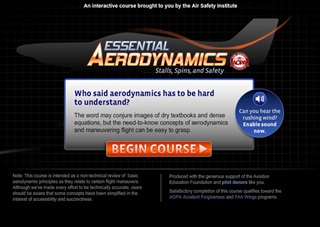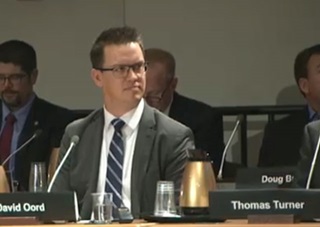
Losing control of general aviation aircraft remains a leading cause of fatalities—accounting, year after year, for about 40 percent of fatal GA accidents, and the NTSB convened a daylong forum Oct. 14 bringing organizations, instructors, regulators, and safety experts together to talk about what can be done to keep pilots safe and in control.
A video recording of the entire forum will be available online through mid-January on the NTSB's website.
AOPA Air Safety Senior Vice President George Perry, a former U.S. Navy fighter pilot was among the first to speak, advocating a multi-pronged approach to the problem that combines technology such as angle of attack indicators and autopilots with envelope protection with a new approach to the basics, including the traffic pattern that GA pilots have been taught for decades.
“I submit that a stabilized approach is just as important to a general aviation pilot as it is to a commercial pilot. The box pattern really sets pilots up for failure,” Perry said, noting that many stall-spin accidents happen when pilots overshoot the turn to final and lose control of their aircraft while trying to compensate. Perry, who flew fighters for 20 years, said military pilots gain a significant margin of safety flying circular patterns, making one, long, descending turn to the runway, and the same practice could be employed in GA. “A circular pattern should be considered an alternative that would allow a more stabilized approach.”
The University of North Dakota also was represented at the forum, and university officials approached Perry after its conclusion to discuss conducting research to determine the benefits and develop standardized procedures for circular traffic patterns in GA.
Fundamental changes to how pilots are tested through the implementation of new integrated and holistic airman certification standards are underway. AOPA Vice President of Regulatory Affairs David Oord reported on the efforts of the General Aviation Joint Steering Committee’s working group focused on loss of control, along with the FAA collaboration with industry to update airman certification and testing standards that produced a comprehensive overhaul now under FAA review and targeted for implementation in 2016. Oord noted that AOPA remains an enthusiastic advocate of easing the aircraft and equipment certification burden that has kept much of the available technology (stick shakers, for example) out of GA cockpits. Certification of electrically driven angle of attack indicators is one sign of progress, though Oord said more can be done to remove the regulatory roadblocks that prevent life-saving technology from being retrofitted in certified aircraft.

“That’s something that we at AOPA feel very strongly about,” Oord said.
Risk management is now being woven into all phases of pilot training and testing. Updating the flight review process is another aspect of the overhaul which Oord said will be critical in helping pilots after their checkride. A risk-based approach to the biennial flight review would make the flight review an opportunity for education and evaluation customized to the type of flying a pilot does, including the aircraft flown and the particular area where the pilot flies. Oord noted that focusing on the risks particular to a given pilot’s flying and location could significantly enhance safety.
The ongoing work of the joint steering committee has produced nearly 30 distinct enhancements and changes to date, an FAA official noted.
Oord said the comprehensive review of airman certification standards, including test questions, revealed a disconnect between what is taught in a classroom and the real-world challenges of flying aircraft. Perry noted that angle of attack indicators are mentioned only once in 119 pages of private pilot test standards, and the same is true of stabilized approaches.
“For those who have flown with AOA (indicators), they never want to fly without it again,” Perry said. “It’s amazing the level of safety that technology now brings to the cockpit.”
Other panelists zeroed in on specific shortcomings in pilot training. Master CFI Rich Stowell, who joined Oord on a panel focused on improving pilot training, pitched a “Learn to Turn” initiative to focus on teaching the fundamentals of this most basic and often misunderstood maneuver. He explained in a subsequent email exchange that most certificated pilots he’s worked with do not understand the aerodynamics of how an airplane actually turns, and what the flight controls actually do during the turn. That leads to mistakes, too often with fatal consequences.
“If pilots really understood what each of the controls does and does not do, then when it came time for some critical maneuvering, they wouldn’t try to turn using the rudder (and stall/spin in on an overshot base to final), and they wouldn’t think and act like this during an engine out close to the ground,” Stowell wrote. He has set up a simple website hoping to recruit support for an initiative to overhaul how turns are taught.
Thomas Turner, executive director of the American Bonanza Society Air Safety Foundation, said type club membership has been correlated by research to improved safety, though it’s still unclear whether type club membership, and the model-specific learning that it facilitates, makes pilots safer, or if pilots who generally follow safer practices are more likely to join a type club. He noted that angle of attack indicators have limits, including lack of standardization of placement and display that make it challenging to interpret the critical information they provide when transitioning between aircraft, and the fact they are calibrated for coordinated flight is also lost on many pilots. Noting that partial panel approaches in instrument conditions account for many loss of control accidents, he advocated for increased use of simulators and flight training devices to realistically present instrument failures to pilots in a safe environment. Research has found that it takes the average pilot several minutes to recognize the failure of a vacuum driven gyro, a critical lag that can contribute to loss of control.
Perry noted that the Air Safety Institute logged more than 2 million “touches” with its array of training courses, videos, quizzes, and seminars in 2014, and the Essential Aerodynamics online course released in 2008 (and soon to be customized for the Apple iPad) has been completed more than 60,000 times to date. The course is among many AOPA Air Safety Institute products related to aerodynamics and aircraft control collected online (and free to all) here.



